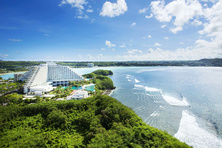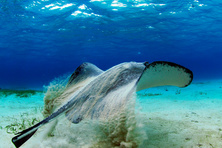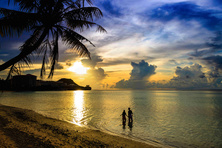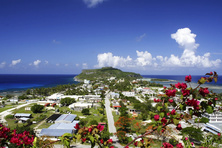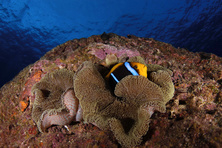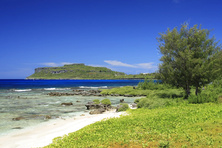Marianas Islands
- Currency: US dollar
- Time: UTC+10
- Languages: English, Chamorro, Carolinian
- Religions: Christianity (Catholicism)
- Sections: Get in Visa Customs Cuisine Money Details of interest Popular resorts
The Mariana Islands are a group of islands in the Federated States of Micronesia in the Pacific Ocean. They are comprised of 15 large islands and smaller atolls. On the Mariana Archipelago, there are two confederations: Guam and the Northern Mariana Islands. These territories are formally under common ownership of the USA.
The average annual temperature on the islands is +28°C. There are two seasons here: a wet season (lasts from July to November) and a dry season (lasts from December to May). Of course, the best time for travelling to the Mariana Islands is a dry season.
The indigenous population is Chamorro people and other ethnic groups of Oceania, the Philippines, and Asian migrants. The official language is English. The locals also speak Filipino and Chamorro. People on the island are the Catholics but traditional pagan cults are also widespread.
Guam attracts the lovers of beaches, divers and scuba divers. There is one of the highest peaks of the Mariana Trench. Blue Hole is a popular place for diving with a cobalt tunnel. If luck is on your side, you will be able to see the dolphins, sword fish or moray. The Saipan Island is the destination for windsurfing and underwater excursions. On the island, there are fields for tennis and golf, and a water park. The fans of snorkelling usually gather on the Corell Gardens in the Sasanayya Gulf close to the Rota Island.
All the Mariana Islands are perfect for hiking and out-of-town tourism. The most famous and popular hiking route includes the Taga Beach which is to the south of San Jose on the Tinyane Island.
Get in
By Plane
There are no direct flights between CIS and EU countries and the Mariana Islands.
The tourists can take a transit flight with a transfer in Shanghai, Seoul or Tokyo and get to the Snipe island for 16 hours.
If a tourist takes a flight with a stop in Tokyo, he or she must get a transit visa.
A transfer in Seoul does not require a transit visa provided the tourist will not leave the airport.
One can get to Guam through Seoul and the journey will take about 24 hours.
Visa
If the CIS and EU tourists are going to stay on the Mariana Islands within 45 days, they do not need a visa.
If their stay will be longer, the tourists must obtain a visa at the Embassy of the USA.
The following documents are required to cross the border: booking confirmation, return tickets, special migration forms (they can be filled in on the web site of the United States State Department or at the checkpoint of the Mariana Islands).
It is not possible to get to the USA from the Mariana Islands without a visa.
Customs
The tourists must be aware of the Customs rules of the Mariana Islands and learn beforehand what they can import and export and in what amount.
The sum exceeding 10.000 US dollars (or equivalent in any currency) and all golden jewellery must be declared.
The tourists are allowed to import cigarettes, alcohol, perfume, personal belongings and gifts according to the limits. The total cost of personal goods and souvenirs must not exceed 1.000 US dollars per person.
Weapons can be imported to the Mariana Islands only if a tourist has a license.
It is prohibited to bring in mangoes from the Philippines and meat that was not produced on the territory of the USA. It is not allowed to import instant food (such as Mivina, for example) which is subject to the USA Law on copyright.
One can bring in pets (cats, dogs, hamsters, ferrets) provided a tourist has a special visa the cost of which is 20 US dollars and an international vet certificate with the vaccination information.
It is strongly prohibited to bring in parrots and other pet birds.
Cuisine
The national cuisine of the Mariana Islands was greatly influenced by the cooking traditions of the Oceania people and by the Spanish cuisine.
The hallmark of the traditional cuisine is sauces and spices and they can radically change the taste of the products. The best known is the sauce Kelaguen with shredded coconut, palm oil and many spices. This sauce is served with meat and fish. The local even eat raw seafood with this sauce. Another popular sauce on the Mariana Islands is Finandeni. It is a mix of red pepper, lemon juice, soy, and spring onions. It is commonly served with side dishes or added to soups. The local soup Kadu and Finandeni sauce is a very delicious combination.
Meat is typically prepared here over an open fire. We recommend trying a traditional festive chicken dish A la Chamorro.
On the Mariana Islands, there is a great choice of seafood and fish. The tourists can try codfish, salmon and exotic seafood such as a delicate trepang, roasted white fish, mussels, octopus, lobster, turtle soup, and broth made from shark’s fins.
Soba noodles or red rice are typical side dishes on the islands. A very unusual side dish here is Shashimi or Pado-laljo (a vegetable mix of eggplant, spices, and coconut water).
Thos who have a sweet tooth can treat themselves to shortbread biscuits Rosquette and a cake Latia with coconut and cream mousse. Fruits are the main ingredients for many desserts.
On the Mariana Islands, they produce a coconut wine Tuba. The taste of the wine is very unusual and we doubt that the EU and CIS tourists will enjoy it. Common European alcoholic beverages are sold in the stores.
Money
The official currency in the Mariana Islands is the US dollar (USD).
On some of the islands, the tourists can pay with Japanese yen.
The travellers can exchange the currency at banks and on bank offices in large cities of Guam and the Northern Mariana Islands.
Credit cards are accepted in large hotels, restaurants, and malls.
We recommend bringing traveller’s checks in US dollars to avoid large commissions. One can cash checks at banks, in the hotels and on large resorts.
On smaller islands and in the provinces, the cards and checks are not accepted.
In shops and on markets, you can pay only with cash.
Details of interest
Traditions and customs of the Mariana Islands were influenced by the Europeans, Asians, Americans, and Spaniards. Only people in the province managed to preserve their native culture. Travelling around the islands always ask your guide about the rules of behaviour in a certain place.
Dances and choral singing is an important part of the culture on the islands.
Sightseeing on the Mariana Islands
On the Saipan Island, a wax figures museum has been opened recently. The 15 expositions will tell you the history of the Mariana Islands from the first Chamorro tribes to the European colonisation. On the Saipan Island, there is everything you need for snorkelling, diving, windsurfing, and underwater fishing.
To the north of the Saipan Island, there are several islands included in the Northern Mariana Islands Reserve. The reserve is the habitat for unique animals and plants.
The city of Hagatna is the administrative centre of Guam since the beginning of the European expansion. It was here where in the 16th century, the Jesuit mission began its spread across the islands of the Mariana Archipelago.
Tumon bay is the largest resort city in Guam with a duty-free trading zone. There are many shops and hotels here. In the Inaradzhan village, the tourists will find the cultural monuments of the Chamorro people. Merisi Bell Village is a must-see on Guam. In the centre of the island, in the city of Barrigada, there are old churches and on the shore of the Umatak Gulf, the tourists will see an old fort. The Memorial Park in the Asan Bay will impress the visitors with its amazingly beautiful panoramic view.
On the Rota island, the tourists can visit the Toga cave which is famous for its wonderful stalagmites and visit the Songsong Village.
Souvenirs on the Mariana Islands
To remember the journey to the Mariana islands, the tourists can buy lucky Bojobo dolls or the seeds of a sacred tree Bojoba.
In souvenir shops, the tourists will find crafts made of coconut, ebony tree, and bones. Woven products from palm leaves, beads and bracelets.
Women can buy natural cosmetics based on noni juice, and men can but a bottle of fruit liqueur.







